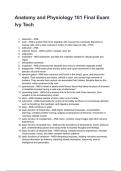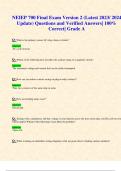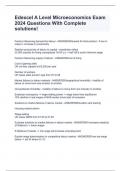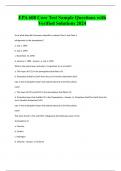Anatomy and Physiology 101 Final Exam
Ivy Tech
1. abduction - ANS-
2. actin - ANS-a protein that forms (together with myosin) the contractile filaments of
muscle cells, and is also involved in motion in other types of cells-- THIN
3. adduction - ANS-
4. Adipose Tissue - ANS-cushion, insulate, store fat
5. adipocytes
6. anabolism - ANS-anabolism- provides the materials needed for cellular growth and
repair
7. dehydration synthesis
8. anaphase - ANS-chromosomes separate and move to centrioles (opposite ends0
9. antagonists - ANS-resist prime movers action and cause movement in the opposite
direction of prime mover
10. apocrine gland - ANS-less numerous and found in the armpit, groin, and around the
nipples. Their secretions are thicker, whitish in color, and contain high amounts of
proteins. They secrete their product into associated hair follicles. Bacteria feed on this
secretion, which produces body odor
11. aponeurosis - ANS-a sheet of pearly-white fibrous tissue that takes the place of a tendon
in sheetlike muscles having a wide area of attachment
12. ascending tracts - ANS-Carry sensory info to the brain (with three neurons), from
receptor to the somatosensory cortex
13. atom - ANS-smallest particle of atom, basic unit of matter
14. autonomic - ANS-responsible for control of the bodily functions not consciously directed,
such as breathing, the heartbeat, and digestive processes
15. base - ANS-combines in water
16. basic function of frontal lobe - ANS-higher intellectual processes, concentration,
planning, complex problem solving, judging consequences of behavior, movement of
voluntary skeletal muscle
17. basic function of occipital lobe - ANS-vision, combine visual images with other sensory
experiences
18. basic function of parietal love - ANS-provide sensations of temperature, touch, pressure,
pain, understanding speech and using words to express thoughts and feelings
19. basic function of temporal lobe - ANS-hearing, interpret sensory experiences, remeber
visual scenes, music, and other complex sensory patterns
20. basic functions of cerebrum - ANS-interpreting impulses, intiating voluntary movement,
storing information as memory, retrieving stored information, reasoning, seat of
intelligence and personality
, 21. basic parts of a neuron - ANS-dendrites, cell body, axon
22. blood - ANS-transports, defends, clotting, throughout body
23. Bone - ANS-supports, protects, forms blood cells, attachment for muscles, skeleton
24. bone function - ANS-shape, support, and protect body structure, blood cell formation,
salt storage
25. canaliculi - ANS-canal or duct
26. cardiac muscle - ANS-heart wall, involuntary, striated, intercalated discs, single nuclei
27. cartilage - ANS-hyaline- nose, ends of bone
28. elastic- ear
29. fibrocartilage- intervertebral discs
30. catabolism - ANS-breaks down larger molecules into smaller molecules
31. hydrolosis
32. centrosome - ANS-produce cilia and flagella, distribute chromosomes during cell division
33. chondrocyte - ANS-cells of cartilage
34. chromatin - ANS-package DNA into a small volume to fit into the nucleus of a cell and
protect the DNA structure and sequence
35. cilia - ANS-propel substances across surfaces
36. circumduction - ANS-
37. cold receptors - ANS-sensitive to temp 10-20C
38. compact bone - ANS-Due to the strength of compact bone, its main functions is to
support the entire body. Compact pact bone also stores calcium
39. convolutions/gyri - ANS-bumps
40. cytoplasm - ANS-contains cytosol
41. cytosol - ANS-aqueous substance
42. define catalyst - ANS-a substance that speeds up a chemical reaction
43. define denaturization - ANS-change the nature or natural qualities of a substance
44. define homeostasis - ANS-maintaining of a stable enviroment
45. define matter - ANS-anything that takes up space and has mass
46. define nucleus, proton, electron, neutron - ANS-nucleus- central part of atom
47. proton- positive charge
48. electron- negative charge
49. neutron- no electrical charge
50. define phagocytosis - ANS-engulfs solids from surroundings
51. define pinocytosis - ANS-engulfs liquids from surrondings
52. define reactant - ANS-starting materials of reactions
53. define synthesis, decomposition, and exchange reactions - ANS-Synthesis- A+B=AB
54. Decomposition- AB=A+B
55. exchange- AB+CD=AD+BC
56. dense CT - ANS-bind body parts together
57. elastic and collegenous fibers, few fibroblasts
58. tendons, ligaments, dermis
59. depression - ANS-







